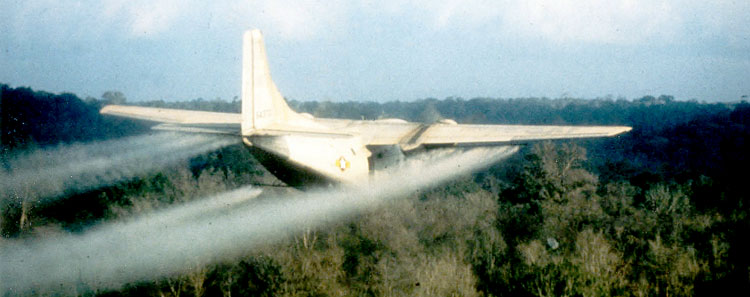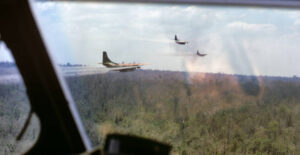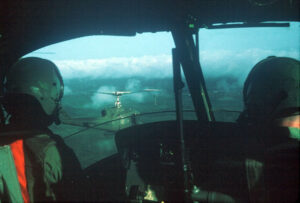
The chemical that became most feared and famous in Vietnam was Agent Orange. Unknown to those handling it, sprayed with it, and later sickened by it, Agent Orange would prove a legacy to Vietnam service and the follow-on devastating Veteran’s diseases.
The chemical was used to defoliate large tracts of jungle or other areas deemed tactically necessary, i.e., destroy the enemies hiding places. Areas previously sprayed would exhibit brown paths marking the defoliation sites. The brown paths were prominently visible both from the air and on the ground. Once sprayed, these areas became toxically contaminated to vegetation, animals, and unwittingly to people. Years would pass before the Agent Orange maladies and diseases became identified.
Unsuspecting ground personnel pre-mixed Agent Orange chemical solutions for delivery mostly by air, either using helicopters or more suitably via C-123 US Air Force transports. US Army helicopter gunships usually provided aerial escort for the low & slow Air Force delivery birds. With a high-speed cruise at 120 knots air speed the Charlie model helicopter gunship could keep up with the C-123 at the same airspeed. A good mission match for both profiles.
The escorting gunships would maintain a flight path behind and outside the spray swath generated from the underwing spray booms on the C-123. Most spray swaths remained in a straight line carried away by the exhaust of the 123’s turbine engines. Two-way radio communication was maintained between the spray ship and trailing helicopters. Any flight path deviations or expected changes were to be announced by the spray ship prior to initiating any change. Except for the one time it wasn’t announced.

Trailing a few hundred meters behind the spray ship to the right and outside the spray swath, it suddenly jinked a slight left turn (with no announcement) throwing the spray directly into my flight path. Before I could deviate, the spray completely enveloped my aircraft. With our open doors the milky, white poisonous liquid swirled around inside the helicopter.
When the spray hit the windshield, it completely blinded me for several seconds. Unable to see outside the helicopter I ‘froze’ on the controls – maintaining the same altitude and airspeed until the high-speed wind deflected the milky liquid away. Thanks a lot for calling the turn!
We breathed in the toxin for several seconds before I kicked pedal side-slipping the air-stream to evacuate the misty spray away from the helicopter cabin. We were saturated and wet. Breaking immediately away from the mission, we returned to Chu Lai home base. Once landed – we shed our clothing and showered as best we could to cleanse off the spray.
Little was known at the time (1969) about the lethality of Agent Orange. The impact from Agent Orange would be felt for decades. Not only were those exposed in Vietnam at risk, but children and family members would later suffer catastrophic disease from its effects.
‘Hot spot, hot spot’ was the call from the lead sniffer ship as we flew low level over the jungle tree tops. The hot spot supposedly marked areas in the jungle where humans (hopefully the bad guys) were camped out.
The ‘sniffer’ was a personnel detector used by the US Army to locate humans by detecting certain chemical odors. An elaborate but bulky system, the airborne unit was mounted inside a UH-1 helicopter with two sensors hanging outside the helicopter. Two technicians would operate and monitor the sniffing progress. The sniffer ship would fly low and slow over the treetops – the chemical techs calling out ‘hot spot’ when the machine readings indicated suspected or potential people presence below.
The Firebirds gunships would accompany and cover the unarmed low flying sniffer helicopter, trailing behind a few hundred feet, and alert to possible enemy activity directed toward the sniffer ship. Low and slow – very low and very slow, listening for the chemical techs call-outs to possibly engage targets of opportunity.

The flight route was pre-determined and followed the terrain contour over the jungle treetops, up and down the mountain sides. The fun part was the low-level terrain flying, the not so fun part was struggling to maintain airspeed and altitude climbing up and over the rising terrain. Calculating airspeed, altitude, rate-of-climb, adjusting power, scanning ahead, to estimate the clearance over the hill crest. Dicey at times but we always made it through.
The mission results were usually inconclusive – the readings designed to detect human chemical odors often detected monkeys and other animals along the way. And as ever resourceful, Mr. Charlie created a low-tech system to mask the sniffer readings. Buckets of urine hanging from the jungle trees gave erroneous readings as the sniffers passed overhead.
The Viet Cong again proved it’s tough for the visiting team to win in the hometown stadium.
All military trainees in basic training are forced to experience the gas chamber. It’s a two-fold purpose: 1) the experience of inhaling a debilitating substance that renders a person incapable of movement along with disorientation, etc., and 2) the importance of donning and fastening your face ‘gas’ mask to prevent #1 from occurring. The first small group would march inside the closed building, once inside the doors would seal the room shut.
The drill sergeants (who themselves were properly masked and protected) would give the command ‘gas, gas, gas’ – signaling you to retrieve your mask from its protective pouch on your right leg and place it quickly over your face. Often the CS gas would be inhaled before you could accomplish the task – difficult to hold that final gasp of air held before you entered the building. Gagging, coughing, wheezing, sneezing would ensue. Once everyone had secured their masks, to their faces (and the Drill Sergeants had insured everyone had a proper whiff of gas), the doors would open for all to run out into the fresh air.
The object lesson was to have your mask readily available and to safely secure it within the nine-second test constraint. Readily available was usually not readily available especially when you needed it most.
It was a miserable, misty, and rainy afternoon at LZ Baldy. The weather was zero-zero – no flying visibility and no ceiling. No worries about a call out for any missions – just kicking back at Baldy. We had been working on assembling rockets, cleaning the expended shell casings out of the gunships when a tremendous thunderstorm hit. Heavy rain with violent lighting striking all around us. The downpour forced us to take shelter inside the gunships parked outside. For several minutes we waited while watching the lightning strikes and listening to the pounding rain on the helicopter cabin roof.

Suddenly a bright flash struck the ground a few hundred feet in front of the helicopters. The lightning bolt had struck and ignited a large container of CS gas. As the rain intensified an unseen cloud of CS gas mixed inside the misty fog drifted toward us. Within a few seconds the gas cloud immobilized everyone – temporary blindness, burning nostrils, gagging, coughing – staggering around with immediate disorientation. Nowhere to run, nowhere to hide – and no gas mask to wear. The gas masks safely hanging on our bunks at the Chu Lai base camp were of absolutely no use to us.
Next day, we kept our gas masks slung over the crew seats whenever we flew.
(c) Copyright – 2023 – Vic Bandini